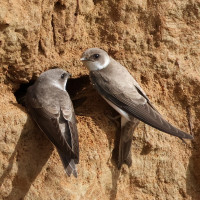Beschreibung
Shallow pools and a larger lake alongside the Coquet, with young woodland and reedbeds. Formerly a nature reserve managed by the gravel company that excavated the site, it was sold to a trout fishery when the gravel company was bought out around the start of this century. Despite this, it still retains some birding interest, though with access limited to a public bridleway along the south side. Hides were put in about 30 years ago but are now decaying and difficult to use; plenty of viewing points from outside though.
The site holds wintering wildfowl (ducks, geese, Singschwan). Seidenreiher are frequent, and Silberreiher occasional. In summer nesting waders (notably Austernfischer, Flußuferläufer, and Sandregenpfeifer; also some Großer Brachvogel). The area also houses a Uferschwalbe nesting colony. Otters are also present.
Details
Zugang
Access using the B6341, running west from Rothbury, through the village of Thropton. Continue west through Hepple, crossing a bridge over the River Coquet. Take the first left turn on to unclassified road and proceed east for 2 km, to the farm at Bickerton. The bridleway is marked on left side if the road immediately after the farm. Park carefully at the side of the metalled road. Walk around 500m along bridleway.
It can also be accessed from Thropton village by following a footpath marked to the left at the west end of the village, from the B6341. Take left fork after 200 m and cross footbridge over the Coquet, then take right fork in path, passing north of farm after 1 km. The route continues west over fields with livestock, total distance 2.5 km.
Terrain und Habitat
Vereinzelte Bäume und Büsche , Feuchtgebiet , Grasland, Wiesen , Tal , Fluss , See , Schilfflächen , LandwirtschaftBedingungen
Flach , Rutschig , Hochwasser möglich , SumpfigRundweg
NeinIst ein Spektiv nützlich?
Möglicherweise hilfreichGute Beobachtungszeit
GanzjährigBeste Beobachtungszeit
Winter , Frühjahrszug , HerbstzugRoute
Normaler Weg , unbefestigte Straße , Schmaler PfadSchwierigkeitsgrad der Tour
DurchschnittlichErreichbarkeit
zu Fuß , Fahrrad , AutoBeobachtungshütten oder -türme
JaZusätzliche Informationen
The hides are now in disrepair and few can be used as intended. View from adjecent to hides.
The bridleway is subject to flooding after heavy rain.




